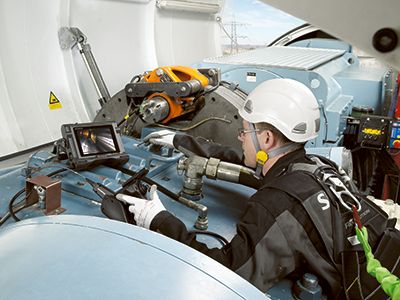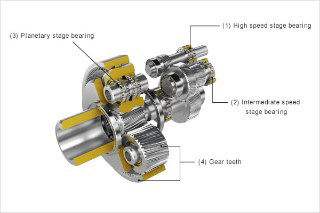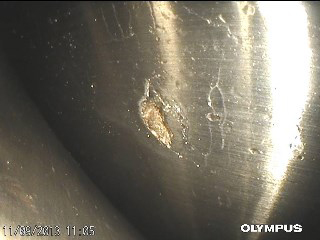Intelligent illumination, maneuverability, and oil resistance help users save time and improve the probability of detection in videoscope inspections of wind turbine gearboxes. The introduction of our oil-clearing tip adapter, which uses capillary action to draw oil away from the lens for clearer images, enables gearbox inspections to continue without the operator having to stop and extract the tip each time it comes into contact with oil. Inspecting inside the gearbox of a wind turbine is among the most time-consuming and difficult videoscope inspections. The combination of its large size, dark conditions, reflective metallic surfaces, and the presence of oil all make detecting damage difficult. Wind turbine gearboxes are particularly vulnerable to damage owing to their extreme operating conditions. High speeds and high stresses mean that small defects can easily lead to gearbox failure or even to turbine fires. Measurement tools, such as vibration sensors, can monitor potential damage continuously, but only remote visual inspection (RVI) provides a thorough analysis of the state of a gearbox (figure 1). So where does an inspector look when inspecting a gearbox? | Figure 1: A look in the gearbox Turbine inspectors use videoscopes as a quick, efficient way to detect gearbox damage. |
Inside a Wind Turbine Gearbox
The function of the gearbox is to convert the slow rotation of the blades and the low-speed shaft into a fast rotation to drive the generator. This process takes place in a series of transmissions (figure 2). During an inspection, each transmission needs to be thoroughly examined, including the gear teeth and the bearings that support the shafts. A typical wind turbine gearbox contains three shafts: the low-speed shaft, the intermediary shaft, and the high-speed shaft. The low-speed shaft is directly driven by the blades and only rotates at a speed of between 20 and 30 revolutions per minute (RPM). However, in adverse weather conditions, the low-speed shaft needs to be able to absorb the extra stresses caused by strong winds. The high-speed shaft, on the other hand, is better protected against adverse weather, but is still vulnerable to damage between 1500 and 1800 RPM. All three shafts are surrounded by stage bearings; these support the different shafts by preventing lateral motion. Some of these bearings—particularly the planetary stage bearings that support the low-speed shaft—are in difficult-to-access locations from an inspector’s point of view. |
Figure 2: Gearing up The turbine’s generator is driven by the blades through a series of transmissions. |
Sharp Images with the Oil-Clearing Adapter
During operation, all gears and bearings are lubricated with oil. This means that during inspection the tip of the videoscope may come into contact with oil, which can lead to blurred images. When this happens, the inspector must retract the tip for cleaning and reinsert the scope tip into of the gearbox and attempt to find its last location. As an alternative, the oil can be drained from the gearbox before the inspection begins, but this also adds to the overall inspection time.
To save time for inspectors, we developed an oil-clearing adapter. This tip helps eliminate the risk of blurred images, so oil on the scope tip is no longer a concern. The adapter uses capillary action to drain oil away from the lens and into channels on the side of the adapter. As a result, you can drain the oil away from the lens without the need for tapping or cleaning while the scope tip is inside the gearbox.
Smart Illumination and Maneuverability with the IPLEX G Lite-W videoscope
To reach every corner of the gearbox—and to take images that give reliable information about the state of the different components—videoscopes need to operate to the best of their capabilities. One important capability is illumination; the combination of large, dark spaces and highly reflective metallic surfaces poses a challenge when trying to produce images with the optimal brightness and contrast for reliable damage detection. To address the issue of uneven brightness across the field of view, the IPLEX G Lite-W videoscope is equipped with PulsarPic processing, which automatically adjusts the illumination. This intelligent illumination processor provides optimized lighting based on the conditions inside the gearbox, which helps to produce clearer images with less noise and improve the probability of detection (figure 3). Another major obstacle for fast inspections of large systems, such as gearboxes, is difficulty maneuvering the scope tip. During the inspection, a lot of time is spent maneuvering the tip toward the area of target. This means that flexible and fast articulation can reduce the time to bend the scope, so more time can be spent on visual inspection and capturing images. Combining adaptive articulation with an intuitive interface, the TrueFeel power-assisted articulation of the IPLEX G Lite-W videoscope helps improve the inspector's hand-eye coordination. Good maneuverability and adaptive illumination make it easy to insert through narrow openings without damaging the scope tip. |
Figure 3: In the spotlight Adaptive illumination improves the probability of detecting flaws in dark spaces. |
Summary
Videoscopes fitted with an oil-clearing adapter are designed to deal with all the complicating factors of wind turbine gearbox inspections: size, complexity, lighting conditions, narrow openings, and the presence of oil. However, the speed and precision of the inspection rely heavily on several key features of the videoscope, such as adaptive illumination, intuitive maneuverability, and oil resistance. The IPLEX G Lite-W videoscope is equipped with these features to save time and help to produce clearer images, thereby improving the probability of detection and contributing to wind turbine safety.





